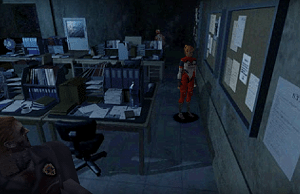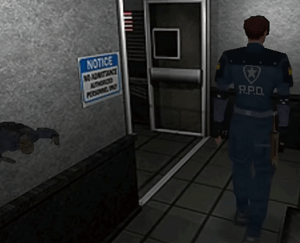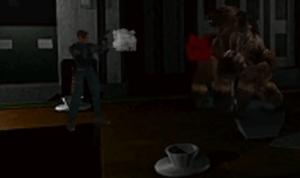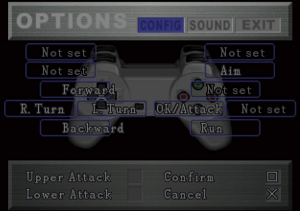
Hey everyone, it’s Kern here. I want to take a brief interlude into the troubles of game design, and the subsequent cancellation of what would be Resident Evil 2‘s first iteration.
Thank you to our patrons for supporting our content.
Unfortunately, that particular version of Resident Evil 2 was canceled. It is now known by hardcore fans as Resident Evil 1.5. Frankly, this unreleased attempt of a game deserves a discussion or two, and that’s the reason for this post.
It’s a shame that director Hideki Kamiya, and producer Shinji Mikami, hadn’t been able to see eye-to-eye on the game. If they had, the Resident Evil 2 that we know and love might have been vastly different.

As a failed prototype, Resident Evil 1.5 is an interesting look into what Resident Evil 2 could have become. There is no official release of Resident Evil 1.5. Thankfully, the build of Resident Evil 1.5 was leaked on the internet back in 2013. Fans of the series have managed to cobble together some form of playable version.
If you look hard enough the content for 1.5 is out there. If you can’t find the game to play yourself, there is plenty of game footage among members of the survival horror community. It’s worth a look at the very least.
Before we do that, though I just want to remind you that I already did a review of the first game. If you want all of the nitty-gritty about that, you should likely read that first.
The original Resident Evil was a huge success. The game was foundational to the survival horror genre, it gave rise to it, truth be told. Resident Evil did one thing above all else, it proved that gamers had a true hunger for survival horror, and a ravenous craving for more games in the genre. This would lead to many iterations and spin-offs over time, but Resident Evil was the first of its kind to popularize the genre.
Resident Evil Retrospective Review
Resident Evil features a fairly typical story. A rescue mission is taking place. With a string of murders running rampant across the fictional Raccoon City, it’s up to the police to find…
Failure to Launch

The success of the first game was so large that it stood to reason that they’d make another. Just a month after the original game was released, development began for a sequel. Hideki Kamiya was slated to direct the new game. Shinji Mikami was going to produce it. These two masterminds dove into their new concept, eager to make a much better survival horror experience.
They had big plans to surpass the fandom’s expectations when it came to the new game. That wasn’t going to be an easy thing to do, either. They had high hopes to fulfill here, both for themselves and for the growing number of Resident Evil fans. Initially these two men had three core ideas on how to make the sequel even better than the original.
- Firstly, they wanted to make playing the game feel more dynamic. They felt that the first game wasn’t as strong as it could have been in this area.
- Secondly, they planned to vastly expand the scope of Raccoon City. They wanted to broaden the scope of Resident Evil‘s already compelling narrative.
- Thirdly, they wanted to include a wider range of highly detailed and stunning pre-rendered backgrounds. This would lend the game even better imagery than what was provided in the original game.
Unfortunately, this new vision wouldn’t be the one to be published. Hideki Kamiya and Shinji Mikami had all of the building blocks for a great game in place. However, each of them had different artistic visions.
Originally, Shinji Mikami wanted to complete the entire Resident Evil story with the sequel before moving onto other projects. He didn’t want to linger on this franchise for too long.

Hideki Kamiya vastly disagreed. He wanted to make a longer, more complex story. He planned on using the sequel to expand on Resident Evil‘s core themes. to create a wider universe.
In the end, Shinji Mikami eventually took a few steps back from the creative development of the game. It was his belief that the game was lackluster. He felt that the narrative was lacking something important. In his opinion, the game mechanics and story just didn’t meld together seamlessly. He asked to be kept informed about the game’s development, but otherwise handed the reigns over to Hideki Kamiya completely.
During the development cycle, Resident Evil 1.5 was nearly eighty percent complete before it was scrapped entirely. A new scenario writer had joined the team and everyone agreed that it was just better to rebuild the game from scratch.
Key Differences
Firstly, I suppose, is the game itself. Resident Evil 2 as we know it today is vastly different from Resident Evil 1.5. Many of the assets from the project couldn’t be used in the release of Resident Evil 2, most of them had to be remade. That being said, some of the modded versions of Resident Evil 1.5 use assets from the Resident Evil 2 game. They do this to help fill in the gaps in the unfinished product.
The story has quite a few changes in it too. Now, to be clear, the story wasn’t completely fleshed out in Resident Evil 1.5, and that reflects in the media. That said, the story as we do know it is vastly different.


In Resident Evil 1.5, the S.T.A.R.S operatives manage to convince the authorities that Umbrella is up to no good. They report that Umbrella was directly involved with problems in Arklay Mountains and within Spencer Mansion. During the game, this is referred to as the “Umbrella Incident”.
The Raccoon City Police were shutting down Umbrella’s laboratories, but the city isn’t safe. A massive viral outbreak has overtaken the city, and it’s the T-Virus.
There is a lot of political intrigue in Resident Evil 1.5. Subtext and implication suggests that Umbrella only released the virus to quiet the naysayers and silence opposition. The story slowly unfolds as the player experiences two different scenarios, starring two different characters. There are some interesting additions to the supporting cast as well.

The first is Leon Kennedy, a familiar name to anyone who knows of the Resident Evil franchise.
Leon’s personality stays much the same, and his basic story plot does too. Very little changes with him, and its clear that he was fleshed out conceptually very well from the start. Leon is still the rookie police officer we all know and love, but thankfully this time around it isn’t his first day on the job.

The second character is Elza Walker. she is a student at Raccoon University. Let’s be honest, she’s no Claire Redfield, that’s for sure.
Elza is a motorcycle enthusiast who returns back from a long vacation only to find that the city is completely overrun with zombies. She ends up crashing her motorcycle into the main lobby of the police station and closes the shutters, locking her inside.
Classic Leon is awesome in both 1.5 and Resident Evil 2. Though, I must say, the same doesn’t hold true for Elza. I prefer Claire over Elza any day.
No matter what scenario is chosen, the goals are roughly the same. Players must find a safe way out of the police department, save any survivors, and get out of the city. As far as survivors go, there are several.
The Birkin family makes a full fledged return. Sherry is still a child that needs protection. Annette and William are her parents. Ada Wong, Marvin Branagh, and Brian Irons, have returned as well. In Resident Evil 1.5, their roles have changed drastically. This is probably one of the most important reasons to play Resident Evil 1.5, because it gives us a look at what these characters could have been.
I won’t spoil too much, but there are some interesting things to take note of. In this version, Marvin spends a great deal of time with Leon throughout the game. Ada is an employee of Umbrella, she was under arrest until the outbreak occurred. Brian is more level headed, and less murderous, but his role is very small.
Mechanics: The Good, The Bad, The Broken…
There are a few oddities to make note of. Computers in the game make a point to remind the player to save their progress, but, there are standard Resident Evil typewriters too. I’m not really sure why the save system might be implemented in this way, but it is an interesting little detail.
You’ll have to be careful when running around. The game was still in development when it was scrapped, so there are plenty of broken boundaries.

You clip through things that you shouldn’t be able to, and all enemies can be seen. Yes, that also means you can see them through walls.

If you notice, it looks like Leon is standing on the table in this photo, and there are plenty of moments like this. Trust me, that’s not a rug. I assure you that dark square thing is, in fact, a table.
Furthermore, there is a huge range of weaponry to choose from in Resident Evil 1.5, but some of the items don’t have assets. Using an item that doesn’t have assets will crash the game.
Puzzles look to be standard Resident Evil format, though most aren’t completely implemented. You can go through the entire game without collecting key items. This is likely a good thing.
Other than that, playing Resident Evil 1.5 isn’t too different from the classic Resident Evil 2. There are more zombies on screen at any given time, and even other enemies can come in small packs. Tank controls and fixed camera angles make a return, of course. Anyone who has played the classic titles in the series will be well acquainted with them by now.
There’s just one problem. The controller can be very wonky…

The game never had an official console release. That means you have to play the game using an emulator. If you’re like me, you use an Xbox 360 controller. The directional pad on Xbox 360 controllers are a piece of garbage, and it can make playing the game difficult. If you have a controller with a better directional pad, you should use it.
The rest of the mechanical changes are small, but I have to admit that I actually prefer most of them. Shotguns can still completely destroy a zombie. However, you can’t aim upwards to take off a zombie’s head. Shotguns will only rip the zombie in half. This can be used to incapacitate a zombie entirely. If you aim below the belt, you can even take their legs clean off. I have to admit, it’s a nice touch.
There is one awkward thing, though. When comes to health bars and status effects, your character will show signs of being injured by having ripped up clothing or seeping wounds. This was a nice idea in practice, but for me it kills immersion. Obviously when you heal back up, the wounds go away and the clothing goes back to normal.
This looks a little odd, and quite frankly, I prefer the limping and slower movement speed that’s found in most classic iterations of the franchise. It simply works better in my personal opinion.
Interesting Visuals and Soundtrack
The sound design is a masterful mix between the first and second Resident Evil titles. The music itself has that classic Resident Evil vibe to it, but there is no voice acting in the game. Due to the fixed camera angles, it’s important that each monster has an auditory cue so that players can hear when they’re just off screen. This ethos is the same in all of the classic titles, and it makes a return here as well.


Visually the game is impressive for its time. However, as a fan it’s hard not to notice something. There is a strange middle ground between Resident Evil graphics and Resident Evil 2 graphics. Resident Evil 1.5 fits perfectly in the center of all of it, showing off what would happen if you merged the two styles completely. Everything is slightly more improved visually from the first game, but, the Resident Evil 2 that was officially released is by far better looking.

My favorite place has to be inside the police station. There’s a cold, sterile feeling that comes along with it. The colors are often muted, meaning that even the brown cardboard boxes on shelves become eye-catching. Truthfully, it isn’t as interesting as the police station in Resident Evil 2, but, it has its own charm to it.
Final Thoughts
There are a lot of good things to come out of this failed prototype of a game. In truth, there are some less than stellar things about it too. It has flaws in spades, but, that’s the point of playing it.
Resident Evil 1.5 is a stepping stone for classic survival horror. It conceptualizes a game’s development cycle in a way few prototypes can. That shouldn’t be overlooked.
The hard work and love that staff put into their crafted worlds can’t be understated either. This prototype was a steppingstone that showcases just how much effort it takes to make a series like Resident Evil.
Fans of the franchise shouldn’t miss the opportunity to experience this prototype in one way or another. If you have the chance to play Resident Evil 1.5, you should. If you need to watch someone else play it, you should still do it. The experience is worth the time, and I can’t stress that enough.
This has been Kernook of The Demented Ferrets, where stupidity is at its finest and level grinds are par for the course. I’ll see you next time.
Meanwhile, check out some of our other great content below. You can also find more information about supporting us at the bottom of this post.
With your contributions, you make our efforts possible. Thank you for supporting our content. Patreon supporters receive access into our official Discord server, and a few other perks depending on the tier. If you don’t care for Patreon, and don’t care about perks, you can always support us through PayPal too… links below.
Those who join via Patreon get special perks, such as extra content, quicker updates, and more.
Patreon Supporters:
($3) Little Ferrets: None
($5) Demented Minions: Francis Murphy and Andrew Wheal.
($7) Fandom Ferret: None
($14) True Blue Ferret: None.
($25) Premium Ferret: None.
($50) Round Table Ferret/Fluffy Ferret: Josh Sayer





[…] After only a month of the first game’s release they knew they’d need to make another. Production began, but the prototype was scrapped, and this failed prototype is known by fans as Resident Evil 1.5 You can read my review of that prototype here… […]
LikeLike
[…] Resident Evil 1.5 (failed prototype) […]
LikeLike
[…] had faced one of these controversies in the past. I’ve highlighted that particular mess with my review of Resident Evil 1.5, which you can read…. The short version is this; Resident Evil 2 had a prototype that was scrapped due to disagreements […]
LikeLike
[…] Resident Evil 1.5 (failed prototype) […]
LikeLike
[…] Academia (Season 1) – [Anime]Perfect Blue – [Anime]Resident Evil 1 (1996) – [Game]Resident Evil 1.5 Prototype– [ Game]Resident Evil 2 (1998) – [Game]Resident Evil 3: Nemesis (1999) – […]
LikeLike
[…] Academia (Season 1) – [Anime]Perfect Blue – [Anime]Resident Evil 1 (1996) – [Game]Resident Evil 1.5 Prototype– [ Game]Resident Evil 2 (1998) – [Game]Resident Evil 3: Nemesis (1999) – […]
LikeLike